

B2C Customer Development, part 1 of 3: Prototyping. Customer development is one of the buzzwords you cannot avoid if you are involved with startups today.
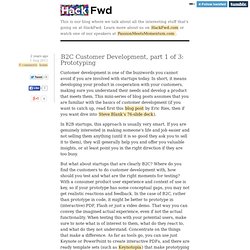
In short, it means developing your product in cooperation with your customers, making sure you understand their needs and develop a product that meets them. This mini-series of blog posts assumes that you are familiar with the basics of customer development (if you want to catch up, read first this blog post by Eric Ries, then if you want dive into Steve Blank’s 76-slide deck). In B2B startups, this approach is usually very smart. B2C Customer Development, part 2 of 3: Finding Users for Testing. You have a B2C product.
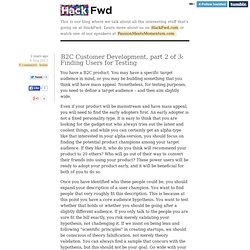
You may have a specific target audience in mind, or you may be building something that you think will have mass appeal. Nonetheless, for testing purposes, you need to define a target audience – and then aim slightly wide. Even if your product will be mainstream and have mass appeal, you will need to find the early adopters first. An early adopter is not a fixed personality type. It is easy to think that you are looking for the gadget-nut who always tries out the latest and coolest things, and while you can certainly get an alpha-type like that interested in your alpha-version, you should focus on finding the potential product champions among your target audience. Once you have identified who these people could be, you should expand your description of a user champion. B2C Customer Development, part 3 of 3: Testing with pre-launch landing pages. Cracking the signup page for a closed beta has become something of a holy grail to many budding startups.

Fueled by success stories from the likes of Hipster, who gathered up tens of thousands of emails without even telling people what they do, and the simple platforms like LaunchRock or MyBetalist for constructing signup pages, it may seem like that’s all you need to build a user base. Why A/B test the landing page In developing a B2C product, a pre-launch (and, let’s be honest here, pre-product) landing page can efficiently validate or falsify hypotheses, check product assumptions and even build a leads list.
But if you only concentrate on the latter, you might skip the opportunity to fine-tune your offering. And this is the cheapest moment to do it, not six months down the line. 12 Tips for Early Customer Development Interviews (Revision 3) Note: also see my 11 Customer Development Anti-Patterns post.
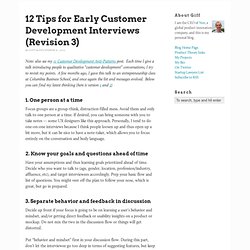
Each time I give a talk introducing people to qualitative “customer development” conversations, I try to revisit my points. A few months ago, I gave this talk to an entrepreneurship class at Columbia Business School, and once again the list and messages evolved. Below you can find my latest thinking (here is version 1 and 2) 1. One person at a time Focus groups are a group-think, distraction-filled mess. 2.
Have your assumptions and thus learning goals prioritized ahead of time. 3. Decide up front if your focus is going to be on learning a user’s behavior and mindset, and/or getting direct feedback or usability insights on a product or mockup. Put “behavior and mindset” first in your discussion flow. The Lean Startup Circle Wiki / Customer Interview Templates and Resources. Tips for B2B Customer Development Interviews by Sean Murphy.
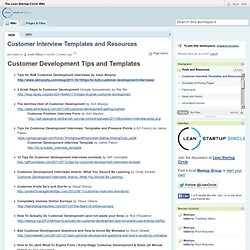
A Guide to Customer Development Interviews. Getting out of the building is easy, getting back with true insights is hard.
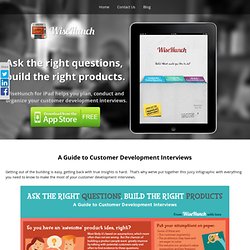
Michael B. Fishbein: How to Deliver Effective Customer Development Interviews. Customer development interviews are designed to validate or invalidate business assumptions and discover product features that solve customer needs.
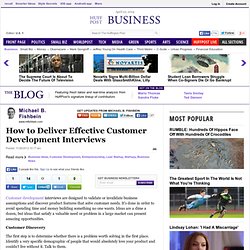
It's done in order to avoid spending time and money building something no one wants. Ideas are a dime a dozen, but ideas that satisfy a valuable need or problem in a large market can present amazing opportunities. Customer Discovery The first step is to determine whether there is a problem worth solving in the first place. Identify a very specific demographic of people that would absolutely love your product and couldn't live without it. What is customer development? When we build products, we use a methodology.
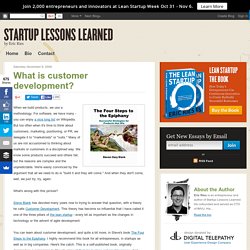
For software, we have many - you can enjoy a nice long list on Wikipedia. But too often when it's time to think about customers, marketing, positioning, or PR, we delegate it to "marketroids" or "suits. " Many of us are not accustomed to thinking about markets or customers in a disciplined way. We know some products succeed and others fail, but the reasons are complex and the unpredictable. We're easily convinced by the argument that all we need to do is "build it and they will come. " What's wrong with this picture? Steve Blank has devoted many years now to trying to answer that question, with a theory he calls Customer Development.
You can learn about customer development, and quite a bit more, in Steve's book The Four Steps to the Epiphany. Some notable bloggers have made efforts to overcome these obstacles. Still, I feel the need to add my two cents. Get out of the building. My final suggestion is that you buy the book and skim it. Customer Development: How to develop your customers like you develop your product.